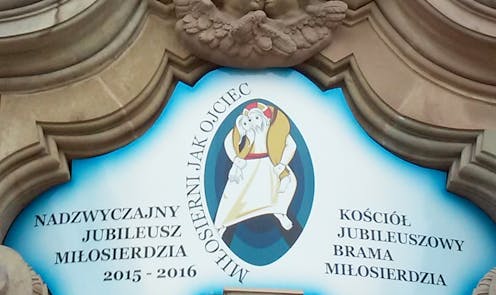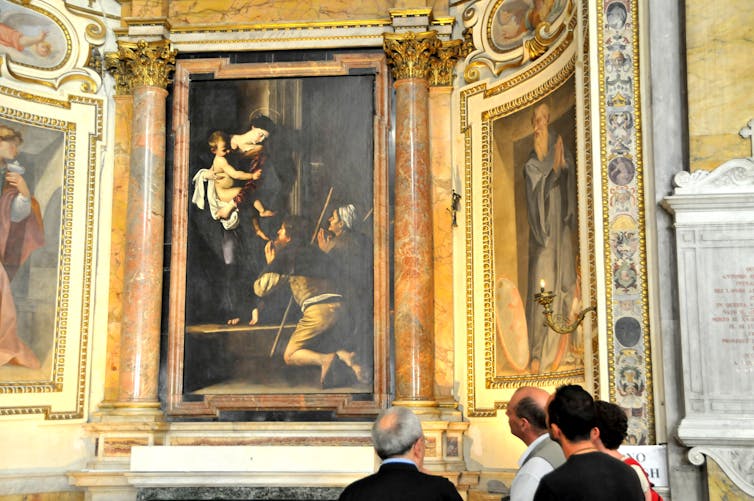Catholics are debating whether to remove paintings by a priest accused of abusing women − but let’s
Marko Rupnik’s art is on display in many churches. Should his paintings be removed in light of recent allegations?

Marko Rupnik, a Catholic priest, was expelled from the Jesuit order because he’d allegedly abused women. He was later accepted into the diocese in his native Slovenia. Rupnik is also an artist, and his work is on display in churches in Lourdes, Rome and Washington, D.C., among others.
Some of these sites are planning to cover or remove Rupnik’s art; some congregants and clergy disagree with such actions. The Vatican’s communication chief, Paolo Ruffini, for example, has defended the Holy See’s decision to keep Rupnik’s art on his department’s website.
As an art historian, I ask whether the debate is missing the point.
Bridging Eastern and Western European traditions
Rupnik’s art has been honored in the past as part of an effort by the Catholic Church to bridge Eastern and Western European faith traditions. With his heritage as a Slovenian, Rupnik was able to create imagery that blended both traditions. He was chosen in 1996 to decorate three of the four walls of the Redemptoris Mater Chapel of the Apostolic Palace in Vatican City with art that symbolized unity between the churches.
In 2016, Rupnik designed the logo for the Year of Mercy, a special spiritual jubilee declared by Pope Francis. Rupnik modeled Christ after the Eastern tradition of the “anastasis,” or resurrection, in which Christ is believed to have liberated the souls of the dead.

Rupnik modeled his painting after a similarly themed 14th-century fresco at Istanbul’s Chora Church. He depicted Christ wearing a white robe, surrounded by an almond-shaped aureole of light. He placed Adam across Christ’s shoulders, a motif derived from early Christian images of Christ as the Good Shepherd.
His work echoed other historical precedents as well. Christ and Adam’s faces were pressed together and they shared a single eye to symbolize that Adam and Christ both shared a human nature. The motif of shared eyes to symbolize the single divine nature of the Christian Trinity appears in the art of the Renaissance.
He was also commissioned to produce the mosaics that adorn St. John Paul II National Shrine in Washington, D.C.
Personal morality and creative production
Many revered works of art come from spiritually flawed creators. Raphael, whose frescoes, such as “The School of Athens,” adorn the room of the Segnatura in the Vatican, reportedly had many mistresses. Italian painter Michelangelo Merisi da Caravaggio lived a short and violent life. He killed a man in a brawl, resulting in his receiving the death sentence for murder. Nonetheless, many of his paintings are seen as deep expressions of faith.
Caravaggio’s “Entombment of Christ,” one of the greatest treasures of the Vatican, depicts the sorrow of Christ’s followers. The artist’s “Madonna of Loreto,” located in the church of Sant'Agostino in Rome, has long been admired for its ability to bring the divine into everyday life. Thin, circular halos hover behind the heads of the Virgin and Child, who otherwise appear as ordinary people and resemble the two barefoot peasants kneeling before them. At the painting’s unveiling in 1606, some were distressed by the lack of dignity in depicting the Virgin and her divine child as commoners.

During my visit to Sant'Agostino in 2009, I witnessed scores of people viewing the painting. Spectators invariably stood next to the peasant’s feet, demonstrating that they could somehow empathize with the pair’s devotion. For over an hour, I was reminded of the power of art regardless of where it came from.
Artists – and all humans – are inevitably flawed; once finished, I believe, an artist’s work is independent of its creator.
From my perspective, condemning art, rather than debating how the Catholic Church may have allowed someone accused of abuse to avoid censure for so long, is a diversion at best.
Virginia Raguin does not work for, consult, own shares in or receive funding from any company or organization that would benefit from this article, and has disclosed no relevant affiliations beyond their academic appointment.
Read These Next
How the ‘slayer rule’ might play a role in determining who will inherit wealth from Rob Reiner and h
These rules have a long history in the United States. They played a role in the notorious murders by…
From truce in the trenches to cocktails at the consulate: How Christmas diplomacy seeks to exploit s
World leaders like to talk up peace at Christmastime. But alongside the tales of seasonal breaks in…
As DOJ begins to release Epstein files, his many victims deserve more attention than the powerful me
Powerful men connected to Jeffrey Epstein are named, dissected and speculated about. The survivors,…





